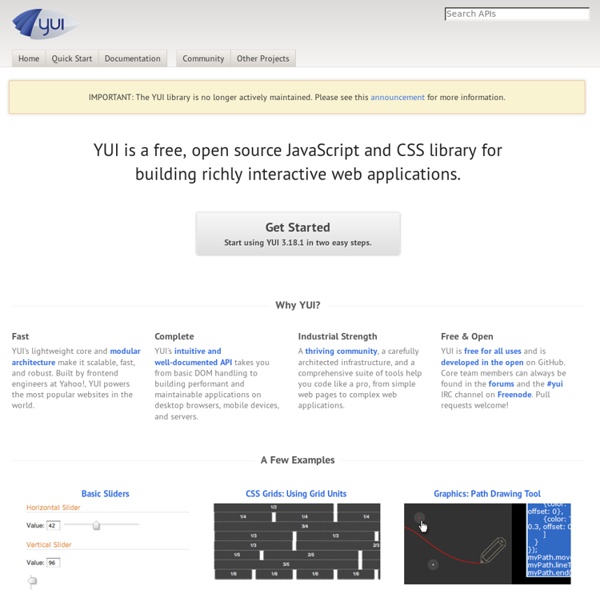



Why Postgres - Craig Kerstiens This post is a list of many of the reasons to use Postgres, much this content as well as how to use these features will later be curated within PostgresGuide.com. If you need to get started check out Postgres.app for Mac, or get a Cloud instance at Heroku Postgres for free UPDATE: A part 2 has been posted on Why Use Postgres Very often recently I find myself explaining why Postgres is so great. In an effort to save myself a bit of time in repeating this, I though it best to consolidate why Postgres is so great and dispel some of the historical arguments against it. Replication
CSS Grids This component is from Pure Grids, which has much more documentation and examples about how Grids work. Note: The file "grids.css" is deprecated, use "cssgrids.css" instead. The foundational CSS Grids provides a simple system for laying out content. The basic components are "grids" and "units". Getting started - Polymer Basics The basics of using Polymer are simple: Load platform.js to polyfill missing platform features, such as Shadow DOM and HTML Imports . Load components with <link rel="import" href="/path/to/component-file.html"> Use the custom element in your page. Here’s a bare bones example:
20+ Sites/Resources to Learn Web Design & Development (For Free) The web design & development education industry has exploded from a small niche to a powerful, continually expanding force. Countless people around the globe are interested in learning about how to design and develop websites, and tons of companies are cropping up promising the ultimate solution. The competition in this field is a great thing for customers. You have more options than ever for learning just about anything you want to know about web technologies. For those, who wants to learn web design and development, we are sharing following high quality sites and resources.
jQuery Quicksand plugin Quicksand Reorder and filter items with a nice shuffling animation. Activity Monitor 348 KB Address Book1904 KB Finder 1337 KB Front Row 401 KB Google Pokémon 12875 KB iCal 5273 KB iChat 5437 KB Interface Builder 2764 KB iTuna 17612 KB Keychain Access 972 KB Network Utility 245 KB Sync 3788 KB TextEdit 1669 KB Demo seems sluggish? Combined Facebook, Twitter & RSS Social Stats with jQuery, PHP & YQL Martin Angelov As we increasingly depend on more and more social services, there rises the need to provide a simple way to let our website visitors take part of our diverse social presence. In this tutorial we are going to create a simple widget, which combines the number of your RSS readers, twitter followers, and fans of your facebook fan page, to give a rough estimate of your social popularity. We are using jQuery and the tipTip plugin, object-oriented PHP, and Yahoo’s YQL, while demonstrating a number of interesting web development techniques. Update (Jun 17th, 2013): All the APIs used in this tutorial have been deprecated or changed, so unfortunately the social stats won’t work any more.
iosSlider – Touch Enabled jQuery Horizontal Slider/Carousel/Image Gallery Plugin Features Hardware accelerated Using CSS3 for supported iOS, Surface, Android and WebKit browsers. Responsive support To work with the most dynamic desktop and mobile sites. 15 jQuery Plugins for Creating Dynamic Layouts Over the last couple of years, with the advancements in web technologies, we have seen a rapid rise in the number of sites that have broken away from using typical and boring layouts. No longer is choosing the number of columns your only option. Nowadays you can easily have a dynamic layout that cleverly and seamlessly arranges content into a grid (masonry), or a parallax scrolling layout, or even a layout that allows you to define a custom path for users as they scroll through pages. At first glance a site with fancy animation effects may seem tricky to build. But that is not the case, as you will discover from collection of jQuery plugins we have for you below. So, break off those shackles and with the help of these plugins go and have fun and build a truly dynamic layout in your next project.
A JavaScript library for building user interfaces A Simple Component React components implement a render() method that takes input data and returns what to display. This example uses an XML-like syntax called JSX. Input data that is passed into the component can be accessed by render() via this.props. JSX is optional and not required to use React.